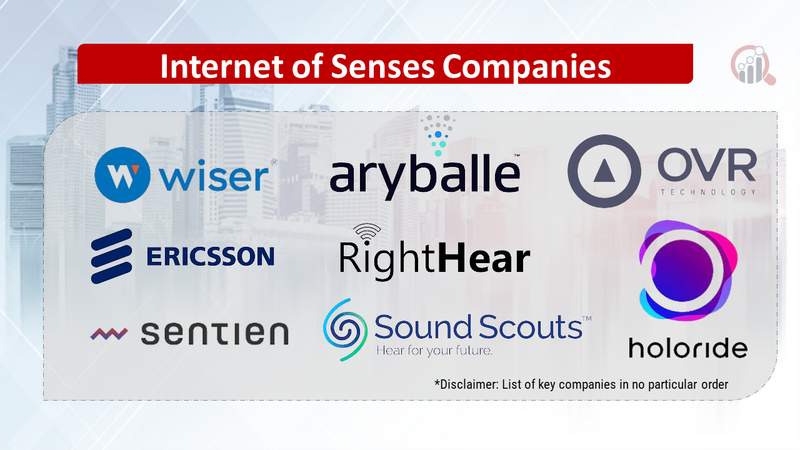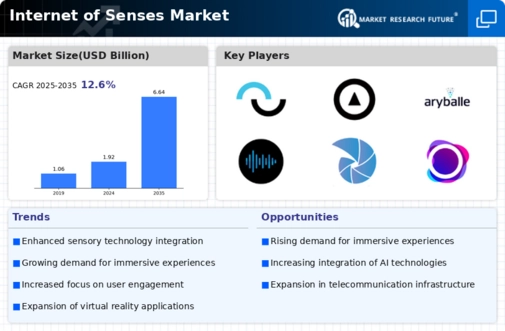Top Industry Leaders in the Internet of Senses Market

Internet of Senses Market: Dive into the Latest News and Updates
Imagine a world where technology transcends screens and seamlessly interacts with all your senses. This is the promise of the Internet of Senses (IoS), a burgeoning market blurring the lines between the physical and digital, offering immersive experiences beyond sight and sound.
Some of Internet of Senses Companies Listed Below:
- Telefonaktiebolaget LM Ericsson
- Mojo Vision
- Wisear
- OVR Technology
- Aryballe
- Vocalytics
- AudioFocus
- Sentien Audio
- holoride
- AlphaBeats
- Sound Scouts
- Artiris Parfum
- RightHear
- Stratuscent
- Moodify
Strategies Fueling Growth:
-
Convergence of Sensory Technologies: Integrating various sensory inputs like sight, sound, touch, smell, and taste into unified platforms creates richer and more immersive experiences, expanding market reach. -
Focus on Specific Use Cases: Developing tailored solutions for healthcare, education, entertainment, manufacturing, and retail applications showcases the practical benefits of IoS and attracts diverse client segments. -
Cloud-Based Infrastructure and Data Analytics: Leveraging cloud platforms for data storage, processing, and analysis enables scalability, reduces operational costs, and empowers developers to create sophisticated sensory experiences. -
Collaboration and Ecosystem Building: Partnerships between software providers, hardware manufacturers, content creators, and industry players fosters innovation, expands application development, and accelerates market adoption.
Market Share Decoding: Key Factors to Consider:
-
Functionality and Feature Set: Platforms offering diverse sensory integrations, robust data management capabilities, and flexible APIs for developer engagement cater to broader needs and attract larger user bases. -
Industry Expertise and Application Focus: Providers with tailored solutions for specific industries, such as medical data visualization or haptic feedback for industrial robots, demonstrate understanding of user needs and capture niche markets. -
Privacy and Security Considerations: Robust data security measures, user control over sensory data, and transparent privacy policies build trust and ensure ethical adoption of IoS technologies. -
Ease of Integration and Developer Friendly Tools: Platforms with open APIs, readily available documentation, and developer support tools simplify application development and encourage wider ecosystem participation.
New and Emerging Stars: Illuminating the IoS Path:
-
AI-Powered Sensory Personalization: Startups like Affectiva and Emotiv explore using AI to analyze biometric data and adapt sensory experiences based on individual emotions and preferences, personalizing engagement and enhancing immersion. -
Biohacking and Augmented Reality Integrations: Companies like Neosensory and CTRL-Labs push the boundaries with sensory augmentation devices, like implantable scent diffusers or wristbands for touch perception in AR environments, creating novel user experiences. -
Brain-Computer Interfaces (BCIs): Startups like Neuralink and NextMind explore harnessing brain signals for intuitive control of IoS applications and virtual environments, opening doors for mind-controlled sensory interactions in the future.
Investment Trends: Where the IoS Dollars Flow:
-
Cloud-Based IoS Platforms: Investors are backing companies developing scalable and easily deployable cloud-based IoS platforms, as these offer faster deployments, reduced upfront costs, and easier integration with existing cloud infrastructure.
Latest Company Updates:
October 20, 2023:
-
Google Research announces Project Soli, a radar-based gesture recognition system: This opens doors for touchless interaction with devices beyond screens. -
Focus on haptic feedback: Advancements in haptic technology enhance touch sensations in AR/VR experiences and gaming.
November 12, 2023:
-
E-commerce embracing scent technology: Companies experiment with scent delivery systems to enhance online shopping experiences.
December 5, 2023:
-
Microsoft unveils "Project Olfaction," a digital scent synthesizer: This technology promises scent messaging and immersive digital experiences. -
Focus on taste and smell sensors: Researchers develop biosensors to quantify and analyze taste and smell for food science and personalized health applications.
January 8, 2024:
-
AI and machine learning (ML) integration for sensory data analysis and personalization: AI algorithms can personalize experiences based on individual preferences and emotional responses. -
Ethical considerations arise: Concerns emerge about data privacy, potential manipulation, and societal implications of manipulating human senses.
January 9, 2024:
-
Augmented reality (AR) applications for sensory enhancements: AR glasses with integrated scent and haptics could overlay digital sensory experiences onto the real world. -
Smart homes embracing the Internet of Senses: Aroma diffusers, haptic feedback furniture, and personalized lighting create multi-sensory environments.

